Prada’s sustainable denim. (Photo Credit: Prada)
Can denim ever truly be sustainable? It is a question that we all ponder, whether you are a fashion lover or an environmentalist. Denim truly is the fabric of our lives, but through the years, denim has earned an ugly reputation when it comes to the environment. Jeans are known as one of the most environmentally damaging items we buy, and the reason is simple: Denim is primarily made from cotton, and most cotton is grown using harmful fertilizers and pesticides. Denim also requires huge amounts of water to produce. One pair of jeans can use approximately 1,800 gallons of water to create. The global demand for cotton (which is used in nearly half of all textiles, according to the World Wildlife Fund) has also led to over-farmed, barren land and soil erosion, which impacts the health of the entire planet. But today, there are many jean companies that are trying to evolve into sustainable denim brands.
DENIM MADE THE OLD FASHIONED WAY
Traditionally, when a pair of blue jeans is created, the cotton denim fabric will be dipped up to eight times in a giant vat of indigo. For the most part, the indigo is in a powder form, subjecting factory workers to dangerous amounts of aniline as they breath-it in. In older factories with dated technology, jeans are placed in belly washers, which can waste up to 1,800 liters of water per pair of jeans. Not only are tons of water wasted, but if the wastewater is not treated properly before getting dumped in local waterway, it can lead to hazardous levels of lead, copper, cadmium, and water with such a high pH, it’s equivalent to ammonia. This has happened in Xintang, China where they manufacture denim.
Also note, that if denim is bleached or distressed, the process can be dangerous and toxic for factory workers. The practice of sandblasting may lead to silicosis and lung cancer. Bleaching and fading jeans using hypochlorite and potassium permanganate generates toxic fumes. Even hand-distressing jeans using power tools will produce dust containing all the dyes and chemicals applied to the garment.
DENIM MADE THE NEW WAY
For those of us who live in denim, there is good news. The denim industry is one of the most innovative sectors of the fashion industry, and they are working hard to create sustainable denim that will not harm its workers or the environment.
For starters, many brands are now using ‘real denim’. Real denim is close-to 100% cotton fabric that is blue on the front (where the indigo-dyed warp yarns show) and white on the back (where the undyed weft yarns show). Real denim is dyed by means of non-toxic synthetic indigo (which is chemically identical to natural indigo) or sulfur black, which is considered a dye of minimum concern to human health. Faux-denim pants that are meant to look like jeans but are made of synthetic fabrics are usually dyed with toxic or reactive dyes. Faux denim does not last as long as real denim, the items usually fall apart rather than breaking in.
Sustainable denim brands generally source their garments from technologically advanced denim mills. A few popular mills that create sustainable jeans are: Candiani in Italy, Saitex in Vietnam, or Denim Expert in Bangladesh. These factories use front-loading washers from Tonello or Jeanologia, which reduces water use by 70 to 80%. When other efficient technologies are added such as water recycling, a pair of jeans can be made with just 11 liters of water (as opposed to 1,800 liters). A highly regarded mill will carefully treat this water to make it completely clean before releasing it.
These technological advanced mills also use lasers, robots, and enzymatic processes that can safely and quickly distress and fade jeans. These highly advanced factories use foam dyeing technology, and dying technology, which both utilize electricity to saturate the yarns—both of these technologies avoid using powder indigo and they only use a fraction of the water that traditional dye boxes need. Many eco-friendly labels today are using natural ingredients instead of toxic chemicals to dye their garments, such as natural indigo dyes derived from plants, shrimp shells, orange peels, and nutshells.
Denim companies can also use sustainable cotton to become greener. Fashion companies should know where their cotton is coming from (what’s called ‘traceable’ cotton) whether it’s from the U.S., from smallholder farmers in India, or from big farms in Australia. Brands should use non-GMO cotton that is sprayed with little to no pesticides, and farms that use natural rather than synthetic fertilizers.
Here are a few sustainable and ethical jeans that have quickly become favorites among the fashion set. Keep in mind that jeans were literally invented as workwear back in 1873; they’re meant to last a few years, if not a few decades. So, invest in the pairs you really love, wear them frequently, and think of every rip and frayed edge as a badge of honor. The more years you own your favorite pair of jeans, the more eco-friendly you’ve become.
LEVI’S
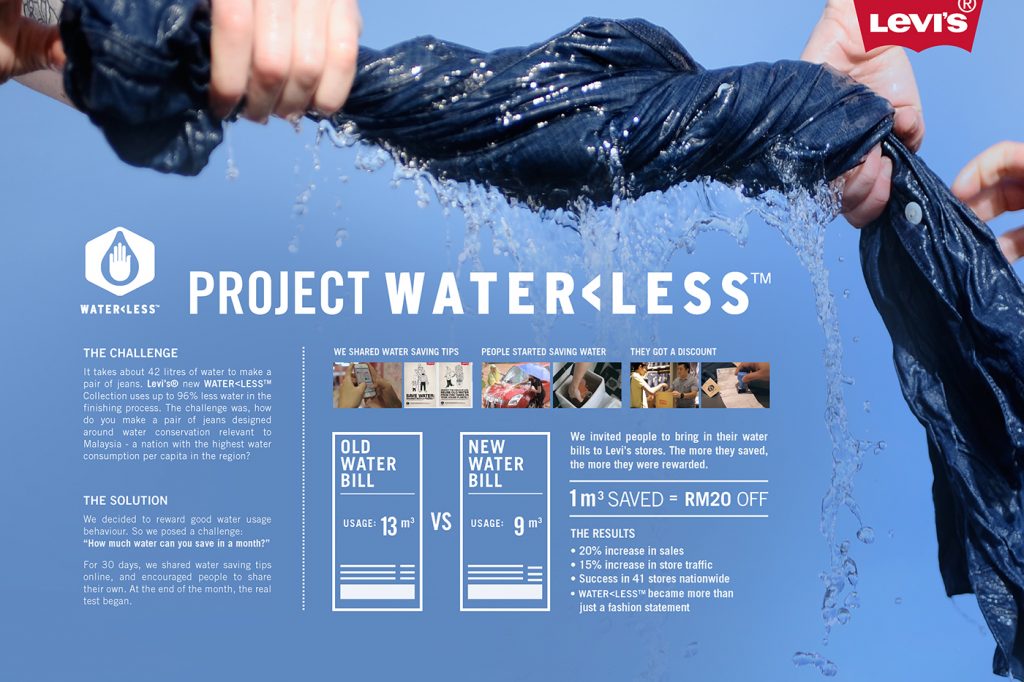
Levi’s Waterless Campaign. (Photo Credit: Levi’s)
Levi’s created the first pair of denim pants. In 1873, two visionary immigrants — Levi Strauss and Jacob Davis — turned denim, thread and a little metal into what has become the most popular apparel in the world.
Today, Levi’s is still a pioneer in the denim industry. Thanks to its trademarked Water<Less innovations, Levi’s has saved more than 1.8 billion liters and recycled more than 129 million liters of water. So far, approximately 40% of Levi’s products use this innovation. Water<Less implements a Screened Chemistry standard which eliminates toxic chemicals from its supply chain. To help avoid ending up in a landfill, Levi’s has partnered with Give Back Box, where you pack up your old jeans and print a free shipping label, then drop it in the mail where it is sent to charity.
AG
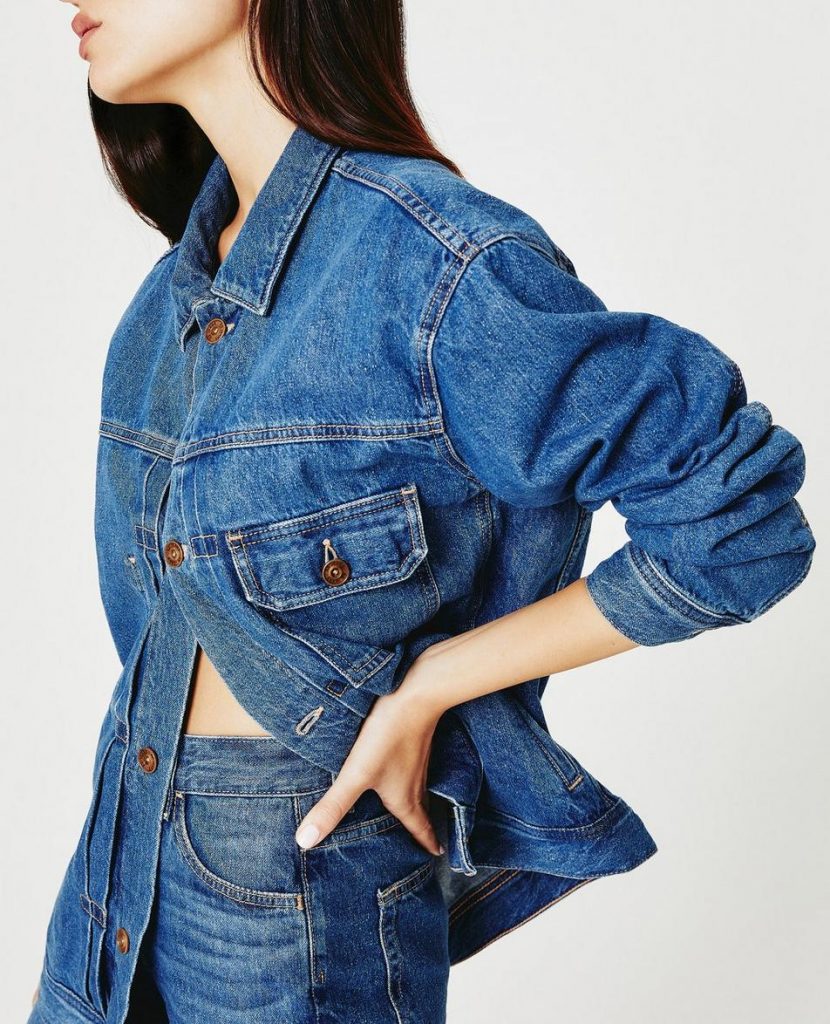
AG Conscious Hemp Denim Jacket. (Photo Credit: AG)
AG has a denim capsule collection called “The Jean of Tomorrow.” This denim capsule collection has a blend of organic cotton, lyocell, and hemp, the jeans and unisex jacket have no metal rivets—instead, Tencel threads hold the fabric together —and rather than metal buttons, they used corozo nuts. The size and care tags were also replaced by screen-printed, soy-based ink. These jeans are 100% natural and biodegradable, so they can eventually be composted and return to the earth.
AG hopes the project can be a model for the entire denim industry in the future: “There is a responsibility for big companies with large manufacturing programs to step up and adopt more eco-friendly processes,” Samuel Ku, AG’s president and creative director, said in a release. “It takes wide-scale investment and adoption to really move the needle in terms of impact, as well as drive down the costs of sustainability so that we can see it become the new norm for all brands.”
DL1961
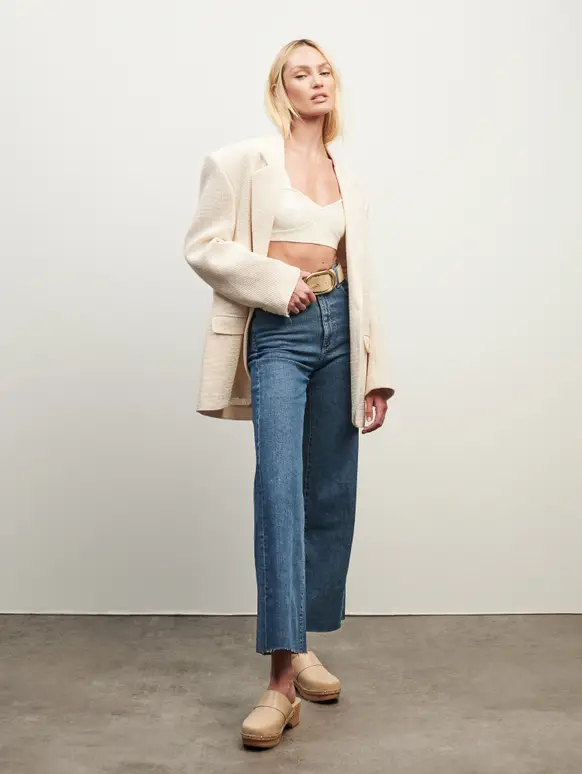
DL1961 and Candice Swanepoel, sustainable denim. (Photo Credit: DL 1961)
DL1961 jeans are created with lower-impact cellulose (i.e., wood pulp) fibers as well as certified-organic cotton and clean indigo dyes that reduce water use and create no harmful byproducts. There factories are a vertical integration, which means there’s less shipping and packaging involved in manufacturing each denim item, reducing both DL1961’s carbon emissions.
RE/DONE
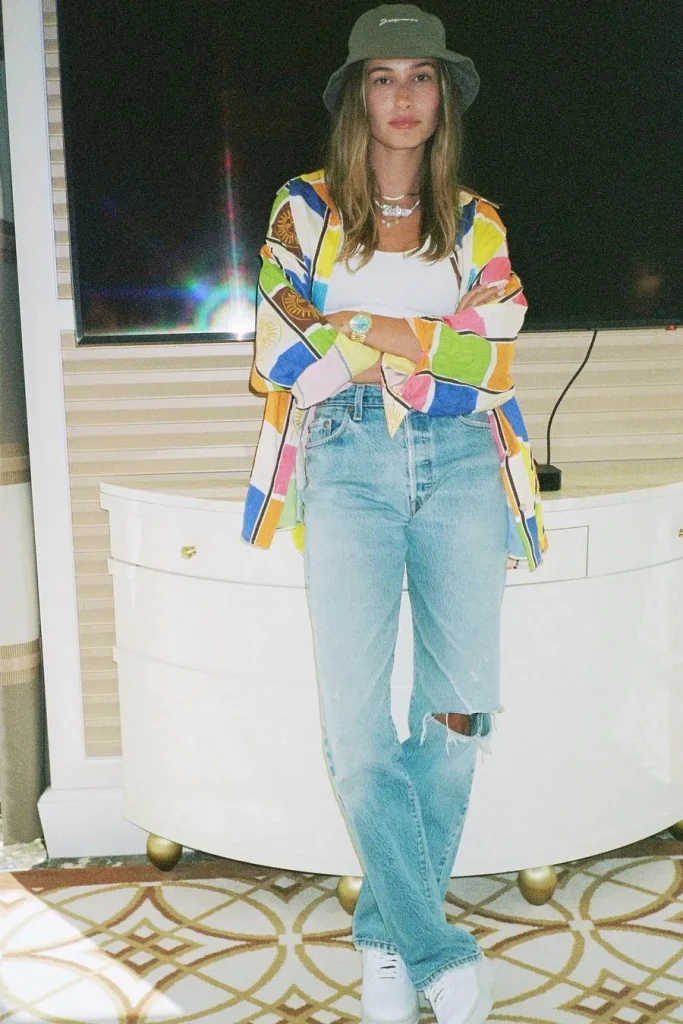
Re/Done sustainable jeans. (Photo Credit: Instagram @ haileybieber)
One of the hottest denim labels Re/Done launched in 2014 with a brilliant concept: vintage men’s denim reworked for women’s bodies. Since then, Re/Done has grown to include new jeans, vintage-inspired T-shirts, dresses, suiting, and a full men’s line. The company also introduced a peer-to-peer secondhand marketplace where customers can buy and sell their Re/Done jeans, T-shirts, blazers, and more.
SEZANE

Sustainable denim from Sézane. (Photo Credit: Sézane)
French label Sézane is loved for its affordable, vintage-inspired jeans, but founder Morgane Sezalory is now focused on sustainability as well. She has reorganized her denim production to include 100% GOTS-certified organic cotton, eco-friendly washing, recycled water, and laser detailing instead of chemical treatments. The founder has taken sustainability for her brand one step further, now all of Sézane’s shipping boxes are made from recycled cardboard or are derived from sustainably managed forests.
FRAME

Frame favorite Le Palazzo jean is made with eco-conscious materials. (Photo Credit: Frame)
L.A. denim brand Frame has introduced a ten-piece denim collection called Pure Denim. These garments are created with 100% biodegradable organic cotton that uses 98% less water in its production process compared to traditional denim processes. Frame’s sustainable jeans come in all shapes, from skinny to wide-leg denim.
SLVRLAKE
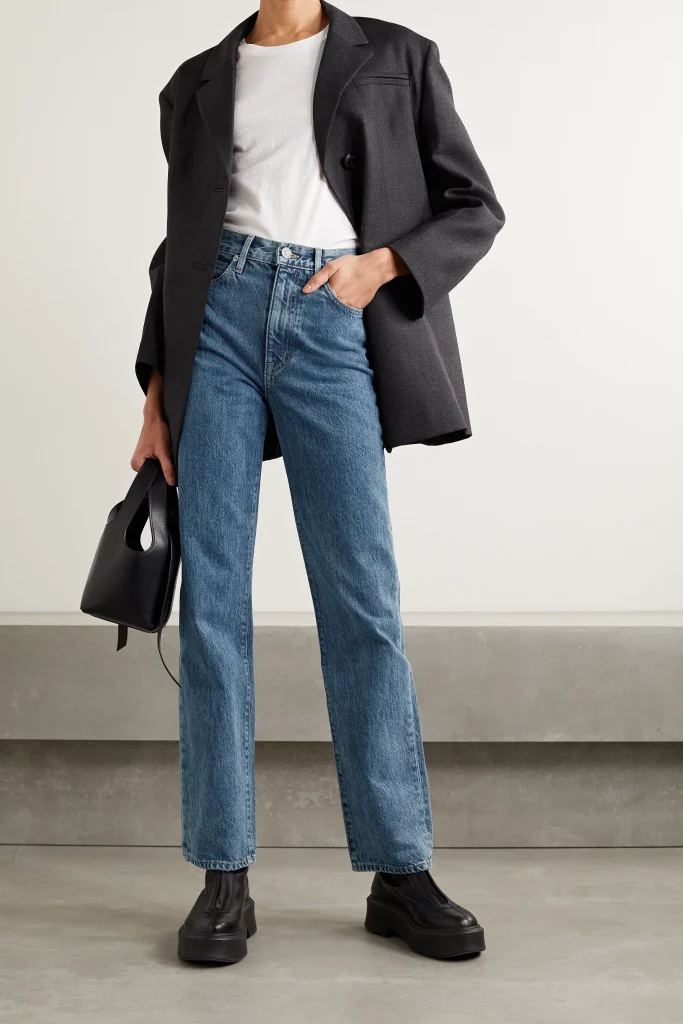
SLVRLAKE’s sustainable denim pants. (Photo Credit: Net-A-Porter)
Louise Edgley, the founder of Slvrlake, is addressing the challenges of cotton by trying something else: hemp. As one of the fastest-growing plants on earth, it can be easily grown without pesticides or fertilizer, requires a fraction of the water needed to grow cotton, and is 100% biodegradable. Edgley’s signature London and Beatnik jeans now come in a soft and durable cotton and hemp blend with a distinctive baby-blue wash.
Citizens of Humanity

Citizens of Humanity’s sustainable denim. (Photo Credit: Citizens of Humanity)
Citizens of Humanity is known for their fashion-forward silhouettes and soft, high-quality denim. Some of the labels most popular fits, like the Annina trouser, now comes in 100% organic cotton and use water-saving, energy-reducing technology. Citizens of Humanity also owns two other denim labels, Goldsign and AGOLDE, which are making similar strides in organic fabrications, laser treatments, and ozone washes, which reduce energy and water use.
EDWIN
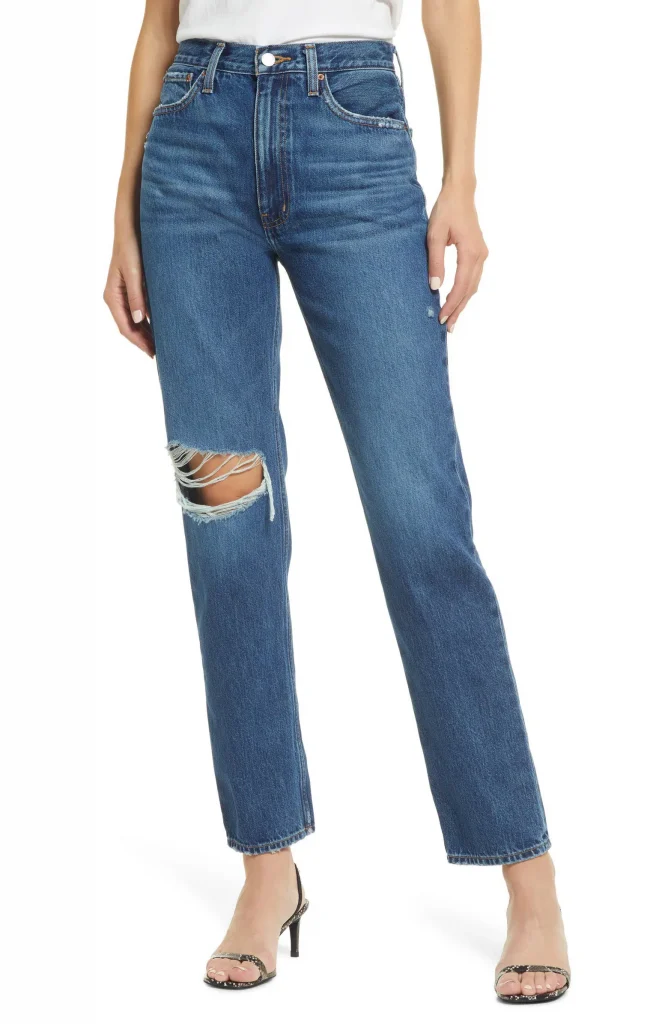
Edwin’s sustainable denim. (Photo Credit: Edwin)
Edwin is a Los Angeles label known for creating some of the best vintage-inspired jeans. Each denim garment is created at Saitex, one of the world’s largest and cleanest denim manufacturers. Saitex now has a factory in Los Angeles, where Edwin is now exclusively producing its collections. Described as “a factory of the future,” the facility comes with everything a fashion label needs to create a lower-impact jean: laser technology, semi-automatic sewing, a water recycling system, and more. The company will also take back your old Edwin jeans and recycle them.
TRIARCHY
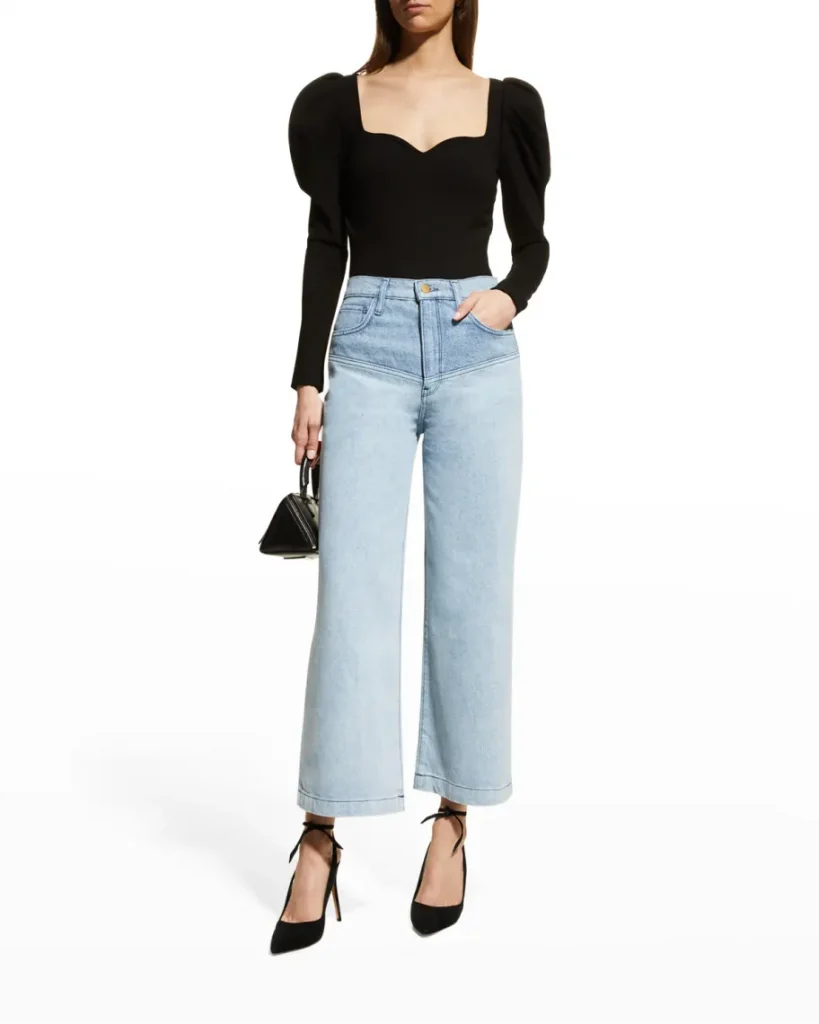
Triarchy’s sustainable denim. (Photo Credit: Neiman Marcus)
Most customers like a little stretch in their denim for comfort, but stretch jeans are make with plastic, which is not eco conscious at all. But Triarchy’s Adam Taubenfligel developed a natural alternative for stretch denim with the Italian mill Candiani, the result, rubber fibers. Triarchy’s innovative “plastic-free skinny jean” feels as stretchy and supportive as any you’ve tried, but the denim is woven with ultra-fine strands of rubber, instead of plastic. The label also offers 100% cotton styles which are also made to the highest sustainable standards with organic materials, natural dyes, less water, and less energy.
ON A SIDE NOTE…..
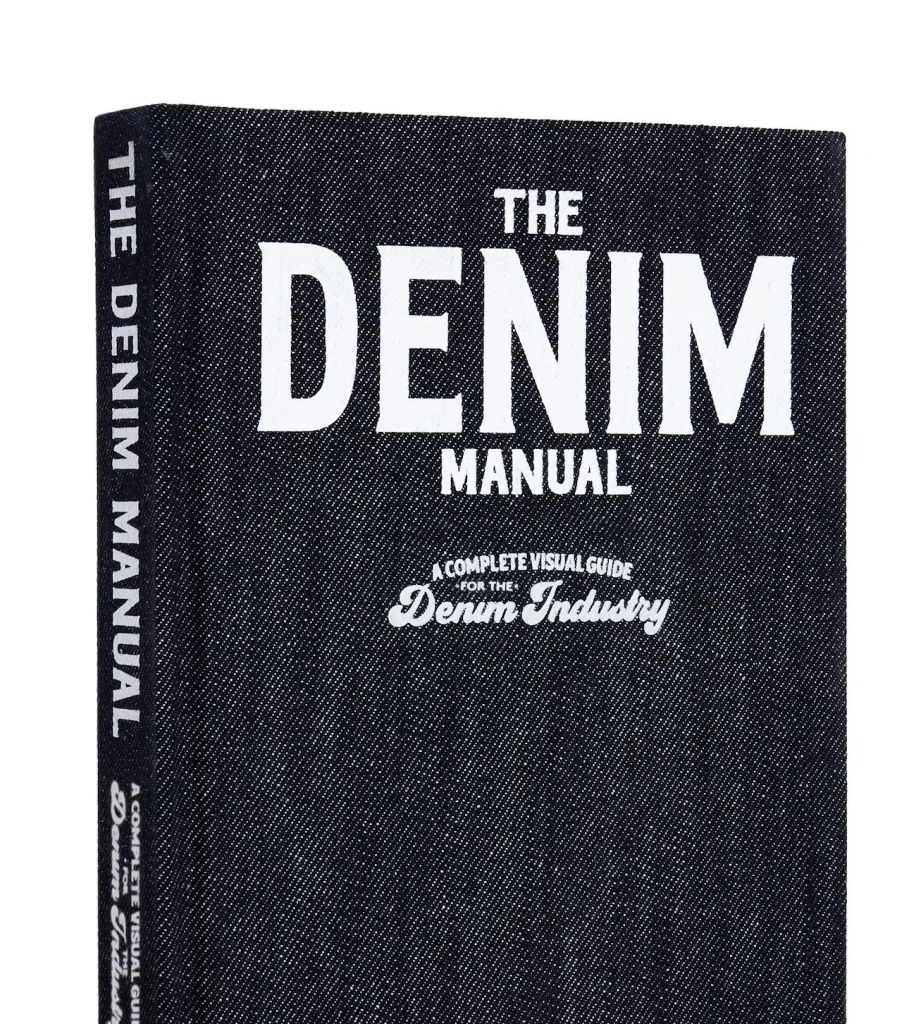
Fashionary’s Denim Manual. (Photo Credit: The Denim Manual)
Want to learn more about denim, well fashion sketchbook producer Fashionary recently released a book titled “The Denim Manual, a Complete Visual Guide for the Denim Industry.” The tome offers a comprehensive look inside the business of denim featuring a cover made of raw denim, and includes over 700 illustrations and photos, as well as a complete collection of denim fabrics, washes and terms that give readers’ an insider’s take on the world of denim.
The book expands from the origin of denim to today’s innovative technology in jeans. There is an illustrated timeline of key events in denim’s history as well as different types of denim fabric. From there, it provides a Denim Design and Details Library of 200 design elements that serves as an encyclopedia of each part of a denim garment.
The book’s Wash Library defines each step for creating various effects such as acid wash and whiskering. It also includes a dyeing guide that covers techniques for achieving a variety of shades and patterns. The final section of the book focuses on maintenance and provides tips for preventing shrinking, fading, and extending the lifecycle of your favorite pair of jeans for as long as possible.
The book is available now for $39.90 on the Fashionary website.
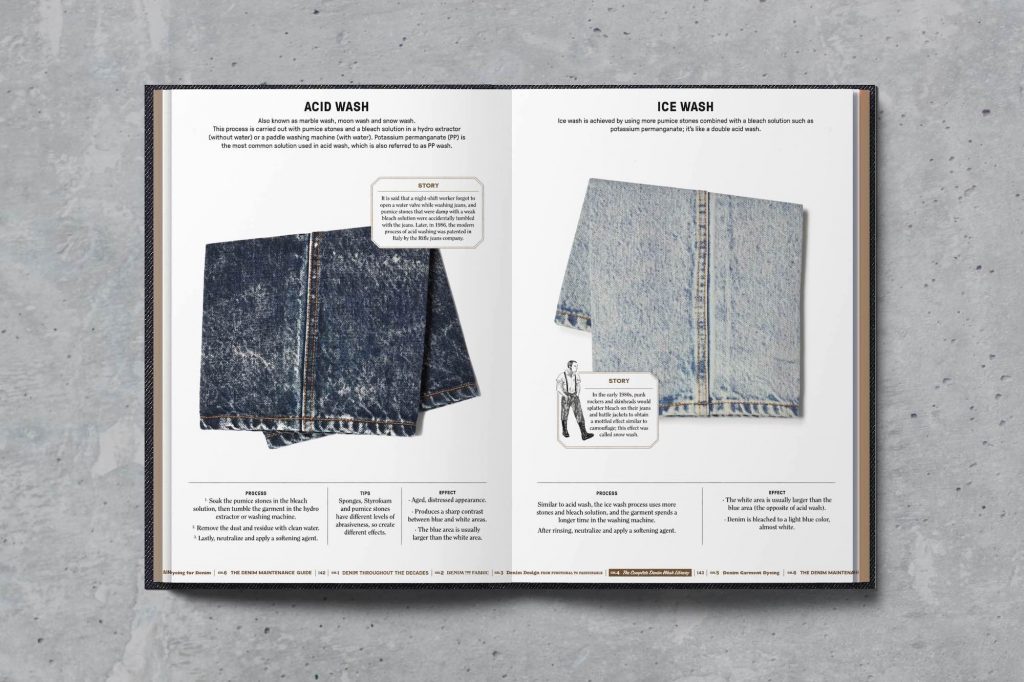
An image from the book The Denim Manual. (Photo Credit: Courtesy of The Denim Manual)
So tell us, will you be more eco conscious when creating your own collections?
-------------------------------------
By: Antonia Sardone
Title: JEANOLOGY: SUSTAINABLE DENIM WE CAN ALL FEEL GOOD ABOUT
Sourced From: www.universityoffashion.com/blog/jeanology-sustainable-denim-we-can-all-feel-good-about/
Published Date: Sun, 08 May 2022 23:55:26 +0000
Read More
Did you miss our previous article...
https://edmmusic.news/fashion-clothing/the-met-exhibit-in-america-an-anthology-of-fashion
 FestivalsMusicNew ReleasesArtistsFashion & ClothingVideosPrivacy PolicyTerms And Conditions
FestivalsMusicNew ReleasesArtistsFashion & ClothingVideosPrivacy PolicyTerms And Conditions
